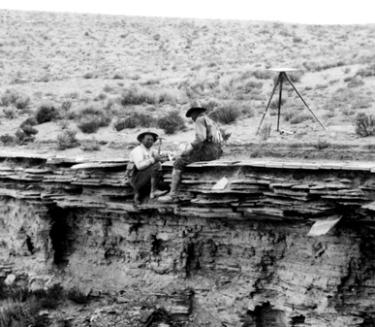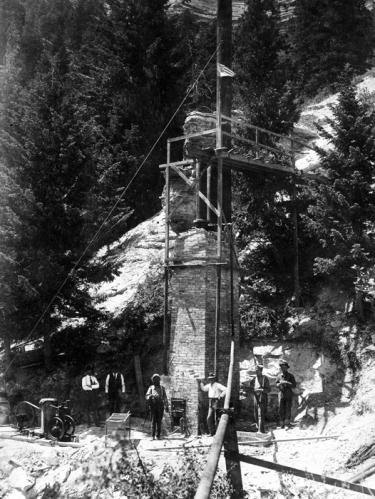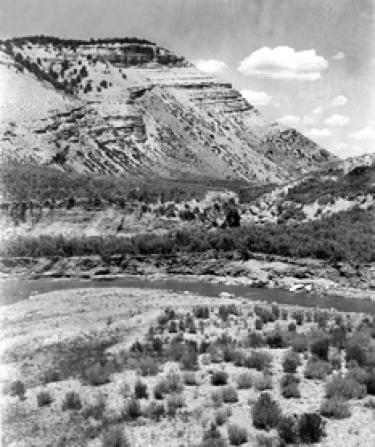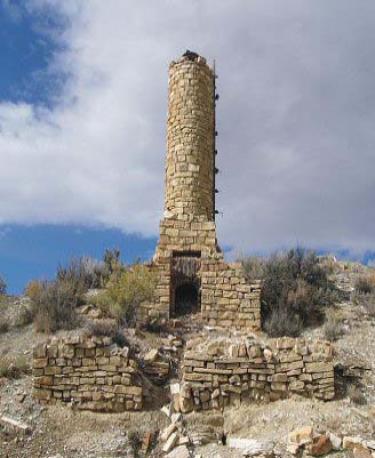Encouraging the First Boom
The First Boom
Federal Encouragement. . .
After flagging for decades in the wake of the 1859 Drake oil strike and the subsequent development of an American petroleum industry, attention to Western oil shale resources revived as World War I engulfed Europe. The US Navy was in the midst of converting from coal- to oil-burning ships and needed a secure supply of oil in case of war or national emergency. The search for this new reliable fuel source prompted the US Geological Survey to explore the Western Slope shale deposits beginning in 1913. Dean Winchester, head of the U.S. Geological Survey, reported that Colorado contained an astounding 20 billion barrels of oil. Critics responded to Winchester with skepticism and he was sent back to the field to double-check his findings. His second report a year later proved his skeptics right, but not how they expected. Winchester found not 20 billion barrels of oil but 40 billion barrels.
In 1916 President Woodrow Wilson withdrew from the public domain 45,444 acres divided between two sites in Colorado and 86,584 acres across the border in Utah for designation as Naval Oil Shale Reserves. (These sites joined already-established strategic oil reserves at Elk Hills in California and Teapot Dome in Wyoming, and were augmented in 1924 by President Coolidge with 23,000 acres in Colorado and 4880 acres in Utah).

As the US geared up for its entry into World War I, officials were optimistic about the development of shale. In his 1917 annual report, Secretary of the Interior Franklin K. Lane reported that “it is now possible to work selected deposits of shale in [economic] competition with the oil from oil wells, and that these oil-shale reserves can be considered of immediate importance to the oil industry and to the defense of the nation.”1
Federal optimism was broadcast and amplified by effusive articles that appeared in influential popular publications like National Geographic and the Saturday Evening Post, in which excited authors extolled the promise of “billions of barrels of oil locked up in rocks” on the Western Slope. 2
As interest spread throughout the West, companies rushed to the Western Slope to make claims on rich oil shale lands. Many of these early companies ironically did not produce oil from shale. James Doyle and Joseph Bellis formed one of the first oil shale companies and produced table tops, bowling pins, and interior decorations from the shale. Some residents produced perfume from shale by-products, marketed shale as a hair-product to fight dandruff and thinning hair, and shale was even sold as a natural medicine. Although none of these ventures ever made significant money, the romantic lore of oil shale ignited human ingenuity for Westerners looking to make profit. 3
Regulating the Boom
Interest and optimism from the federal government triggered the first oil shale boom on the Western Slope. A claimant made the first oil shale claim in 1910 and throughout the decade millions of acres of oil shale bearing lands were staked and claimed. Between 1916 and 1920, a stampede of speculators and prospectors claimed nearly every cliff outcrop in the region – sometimes twice – under the inadequate auspices of the Petroleum Placer Act of 1897, a law that extended the basic principles of the 1872 Hardrock Mining Law to oil development.

Designed to encourage Western settlement, these laws assumed that mining was the most valuable use to which land could be put and made all public lands open to mineral entry, thus establishing a “right to mine” above all other uses of the land. When valuable mineral deposits were discovered, the laws gave claimholders the right to patent the land (that is, to own the property outright by obtaining fee simple title) for $5 an acre. However, the laws were written to govern minerals found in placer deposits (among the gravel of a streambed) and clearly defined lodes (veins running through rock). Gold, silver, and other minerals that sparked 19th-century mining booms could be relied upon to present themselves in one of these two ways, but Western oil shale did not clearly conform to either type of deposit considered in these pieces of legislation.
Without an adequate legal mechanism for governing oil shale, the government found itself with very little ability to regulate mining methods or much of anything else as “oil fever” took hold on the Western Slope.
Lacking a law designed to fit their unique situation, oil shale prospectors were forced to shoehorn the existing laws to fit around their claims. Inviting prospectors to stretch the law during a mineral boom is a sure way of asking for trouble, and the government’s early attempts to apply these inadequate mining laws to oil shale discoveries provided ample opportunity for claim jumping, coattail speculation (letting someone else do all the work to locate a deposit and then filing claims as nearby as possible, if not simply jumping the claim), dummy locations (making a claim with the intent of turning it over to someone else, such as an employer who wants larger holdings than the law will allow), shady stock deals, and other boomtime shenanigans. A new approach to regulating oil shale was clearly needed. 4
Mineral Leasing Act
By 1920, as “oil fever” gripped the nation, enough citizens recognized the shortcomings of the 1897 Petroleum Placer Act that Congress took note. In an effort to impose some order on the chaos of the boom and tailor the law more effectively to the requirements of the resource it regulated, Congress replaced the Petroleum Placer Act with the Mineral Leasing Act of 1920 (MLA). The new law made fossil fuel-bearing lands in the public domain available for development only under specific federally-set conditions that included a minimum royalty payment on production. The law also included a “savings” clause that allowed claimants who had filed their claims before the passage of the MLA to secure private ownership of the oil shale lands. This exception gave the energy industry a foothold on the Western Slope’s public lands that it maintains to this day, but all other oil shale lands reverted back to federal control and were subject to the new law.

The MLA, which (with minor revisions) is still the law governing fossil-fuel development on federal land today, differs from the 1872 Hardrock Mining Law in several significant ways. First and foremost, there is no “right to mine” on the public lands. Unlike the 1872 law, which declares the public domain open to mineral development and ranks mining preeminent among competing uses of the land, the MLA requires would-be developers to obtain permission from the federal government through a competitive bidding process before prospecting or mining operations commence. The government, moreover, retains the discretion to determine which, if any, bid to accept.
When federal land managers do award a lease under the MLA, the lessee must compensate the public for the depletion of nonrenewable energy resources through royalties, rents, and bonus payments, as opposed to the flat $5 per acre purchase fee in the 1872 law. The Secretary of the Interior may reduce, waive, or suspend these royalties in order to encourage development (a provision of the statute that specifically references the promise of oil shale), but in cases when the government does collect royalties, it returns a portion (set at 50% in a 1976 amendment) to the state that hosts the operation. The government offers each lease for a fixed term (usually 5 years for oil and gas), with the option of renewal if the operator is profitably producing resources, as well as an option for the government to compel timely development or cancel the lease if the operator does not proceed with due diligence. When the law was passed, oil shale leases were limited to 5120 acres (8 square miles) and each company or individual miner was allowed only one lease.
The MLA also includes provisions meant to protect the environment, a consideration not likely to have even entered the thoughts of the legislators who authored the 1872 law. Throughout the leasing process, federal land managers have the authority to impose conditions and regulate the extraction process to protect competing resources and the environment. These environmental considerations extend beyond the life of the mine, discouraging the “get rich and get out” mindset displayed by many miners during earlier mineral booms. Those miners fortunate enough to be awarded a lease must promise to reclaim the area – typically by posting a bond up front designated for the purpose – once mining operations have ceased.5
Along with the MLA, a significant legacy of the first oil shale boom was the codification and clarification of laws concerning oil shale claims. A series of court battles between the federal government and claimants over claims made between 1916-1920 filled courtrooms until well into the 1930’s. The case of Freeman v. Summers 1927 (52 L.D. 201) over a claim made between a homesteader and a claimant on the same stake of land established the process for what was considered valid discovery of oil shale deposits. The case became a small-scandal when The New York World ran a series of stories accusing the Department of Interior of illegally transferring thousands of acres of public land to private speculators. The accusations proved false, but the case established a precedent for valid discovery that would be revisited in legal battles over private oil shale claims in the decades to come.
Other cases throughout the boom period established when and if the federal government could reclaim lands, clarified the annual labor clause, established royalty rates between the states and federal government and defined what constituted a valid claim. These court cases and federal acts established a stronger legal mechanism for the oil shale industry to operate within and gave the government the ability to better regulate the oil shale industry. However, many of the early private claims made prior to the passage of the MLA became contentious legal battles that played out in courtrooms much later in the century, a legacy caused by changing legal mechanisms in the midst of the boom. 6
The First Bust
Despite the eternal concern in certain circles that additional regulation will stifle industry, the new laws did not dampen the widespread enthusiasm for oil shale. By 1922 at least 100 companies had formed to unlock the secret of the oil in the rock. That number again and more joined the rush during the mid-1920s, until the onset of the Great Depression and a flood of new lower-cost free-flowing crude oil discoveries conspired to kill the boom.

There wasn’t much to show for all the commotion. The small mining outfits had never been able to raise sufficient capital to pursue ventures on a profitable scale. And, in any case, the industry never developed effective technology to extract and retort the fuel from the rock in a way that would make it competitive with domestic liquid oil. With only token amounts of oil to show for their efforts, companies shut down and abandoned the Shale Country as quickly as they had appeared. While some prospectors pocketed their deeds in hopes of waiting out the bust, most sold their claims to long-term speculators who were willing to bet on oil shale’s future.
Even the federal government got out of the oil shale business. The Bureau of Mines, which opened an experimental mine and processing facility on Naval Oil Shale Reserve land near Rulison (about 11 miles west of Rifle) in 1925, closed its operation in the summer of 1929. That same year, the Teapot Dome Scandal concluded with former Secretary of the Interior Albert Fall going to prison for accepting bribes in exchange for leasing the strategic oil reserves at Elk Hills and Teapot Dome. Eager to preclude any chance of another headline-grabbing scandal in the nation’s energy fields, in 1930 President Herbert Hoover issued Executive Order 5327 temporarily (but indefinitely) withdrawing all federal oil shale lands from lease “for the purpose of investigation, examination, and classification.”7 The gesture was largely symbolic – the boom had played itself out and, for the time being, the industry was moribund.
The first boom-and-bust cycle proved that despites the vast potential of the American West’s oil shale resources, the industry would need more than rising fuel prices and national security anxieties to become an established industry. A sustainable approach was needed and more than a little luck to turn potential into profit.
Notes:
1 Quoted in Russell, History of Western Oil Shale, 5. Wilson’s presidential authority to withdraw public lands from mineral entry had been affirmed by the US Supreme Court the year before in United States v. Midwest Oil Company. For the Winchester story see William Edward Beilke, “Colorado’s First Oil Shale Rush, 1910-1930” (diss. University of Colorado, 1984).
2 See Guy Elliott Mitchell, “Billions of Barrels of Oil Locked Up in Rocks,” National Geographic 33, no. 2 (Feb. 1918): 195-6; and Floyd W. Parsons, “Oil From Shale: Everybody’s Business,” Saturday Evening Post (20 March 1920). These and a thorough list of additional articles on the topic are cited in Andrew Gulliford, Boomtown Blues: Colorado Oil Shale (Boulder, CO: University of Colorado Press, 2003), 54, 247-8, n.2 and 14.
3 Beilke, “Colorado’s First Oil Shale Rush,” 13,33.
4 Russell, History of Western Oil Shale; Gulliford, Boomtown Blues.
5 Charles Wilkinson provides a helpful and concise overview of the 1920 Mineral Leasing Act in Crossing the Next Meridian: Land, Water, and the Future of the West (Washington, DC: Island Press, 1992), 52-8. See also Bartis, Oil Shale Development in the United States, 26-7. Permission to mine is awarded through a competitive bidding process that usually includes bonus payments, and royalties that typically amount to between one eighth and one sixth of total revenues for oil production must be paid on the extracted resource. Typically, the lease is awarded to the qualified bidder submitting the highest bonus bid, since royalties are usually fixed by the BLM in advance. In addition to these provisions for compensation to the public for mineral extraction, the MLA also provides land managers with much greater authority to regulate the extraction process. In keeping with its authority to stipulate special protections for competing resources and the environment, federal officials often prescribe construction standards and access routes to minimize environmental disturbance.
6 Freeman v. Summers 52, L.D., 201 (1927). Ickes v. Virginia-Colorado Development Corportation 295, U.S. 639 (1935) established when and if the federal government could reclaim lands if a claimant failed to perform the $100 annual labor clause as set by the 1897 Petroleum Placer Act. The Picket Act 0f 1910 established royalty rates between the states and federal government.
7 Executive Order No. 5327, April 15, 1930; quoted in Robert P. Baker and Robert D. Mulford, “Problems and Policies in Oil Shale Development,” Stanford Law Review 19, no. 1. (Nov. 1966): 194-5; Anne Wasko, “A Look at Shale Country – January 1981,” Shale Country (Jan. 1981): 5.


